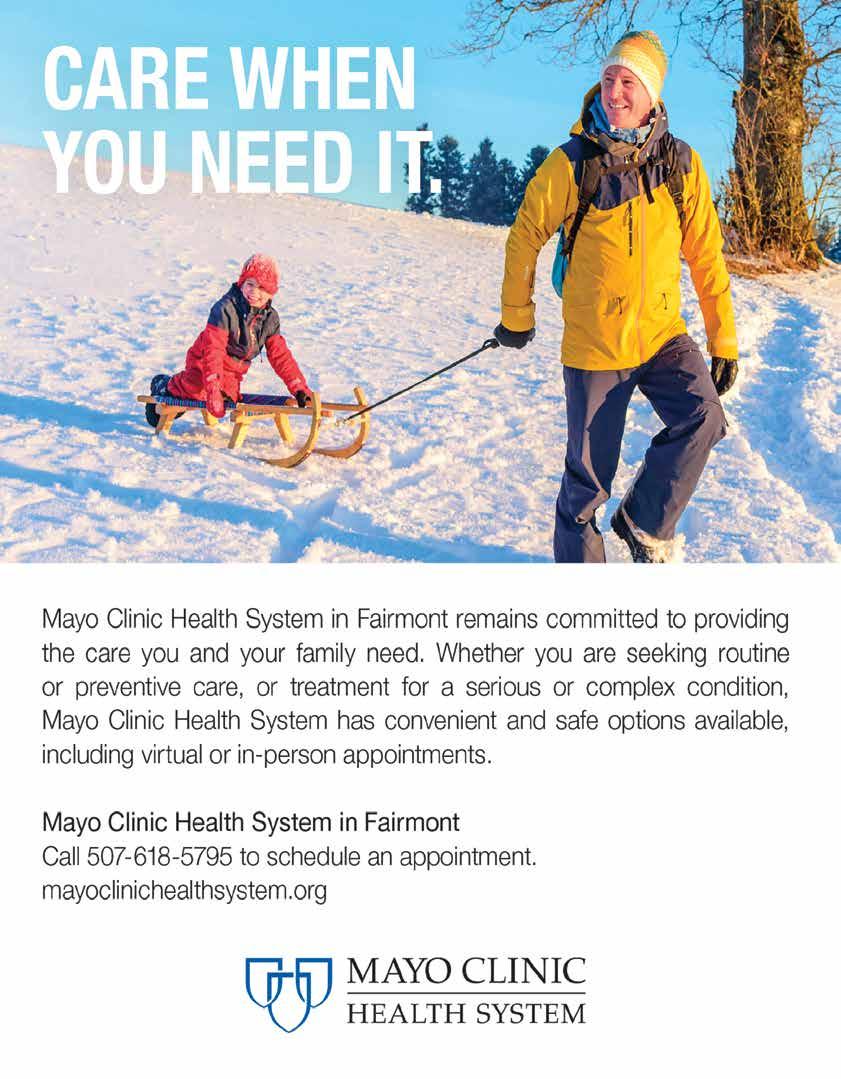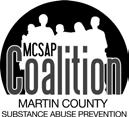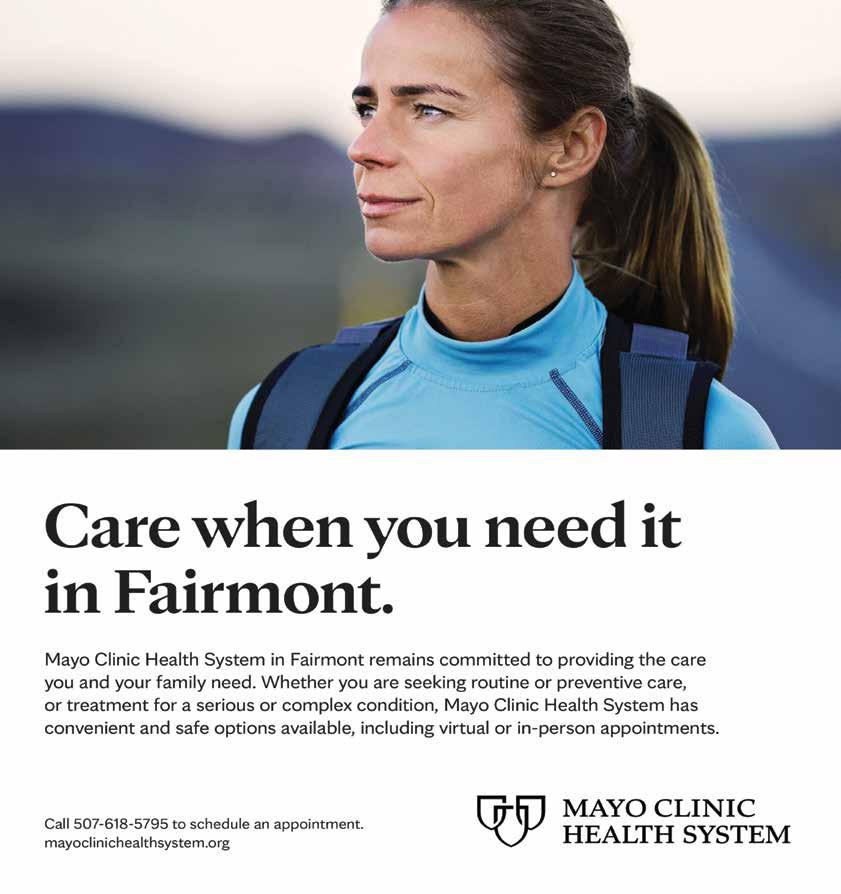
Signs of Use ALSO » Never Delay Dealing with Depression » Effective Coping Skills » Ways to Begin the Year Intentionally » Navigating the LGBTQ Conversation Winter 2023 | www.mcsapcoalition.com BROUGHT TO YOU BY




www.mcsapcoalition.com | YC MAGAZINE | Winter 2023 1 INSIDE WINTER 2023 2 From the Director 5 Confessions from the Kitchen Table 10 Faces in the Crowd 11 40 Developmental Assets 12 Assets in Action 18 Q&A / By the Numbers 6 Never Delay Dealing with Depression 14 Effective Coping Skills 16 Ways to Begin the Year Intentionally 20 Navigating the LGBTQ Conversation 23 Signs of Use FEATURES IN EVERY ISSUE TO ADVERTISE OR CONTRIBUTE, PLEASE CALL (507) 399-1062 MAGAZINE DESIGN BY BROUGHT TO YOU BY PRODUCED IN CONJUNCTION WITH
Kari Matejka and Kylar Larson were nominated for our cover because of their leadership at Martin County West. Kari is in many activities, including FFA, student council, basketball, and band, and she is a Statewide 4-H Ambassador. Kylar is class and student council president and is in choir and track and field. Both students work at Live Fit, like challenges, and find a way to succeed. “They are just really amazing humans who will inspire others by their actions!” said Laura Ebeling, MCW staff.

ABOUT MCSAP
Martin County Substance Abuse Prevention (MCSAP)

Coalition is a non-profit organization led by a diverse group of Martin County residents who have a passion for helping youth make healthy choices. Formed in 2011, MCSAP functions as a hub of information and resources to help coordinate and support the efforts of substance abuse prevention and the mental and physical well-being of youth. Coalition members include school teachers, police officers, volunteers, nurses, pastors, lay ministers, grandparents, parents, youth, and many others who care about the youth in our communities.
The youth coalition is comprised of students in grades 7-12 at each Martin County high school. Members encourage fellow students to say no to tobacco, alcohol, marijuana, and prescriptions that were not prescribed to them. Student members reach their peers through positive messaging in personal notes, posters, and flyers; training opportunities; distribution of educational information at community events; and coordination of safe and fun activities, among other outreaches. If you are interested in learning more about the youth coalition activities at your school, contact the following advisors: Jim Utermarck, Cairne Eytcheson, Truman; Elizabeth Lowry, Fairmont; Kari McGregor, Karen Weets, Granada Huntley East Chain; Laura Ebeling, Heather Winter, Martin County West; Lisa Kube, Martin Luther. If you are interested in joining MCSAP or being kept up-to-date on our activities, join our mailing list by emailing director@mcsapcoalition.com. You can also learn more about who we are and what we do through our social media pages. On Facebook and Twitter, we are MCSAPCoalition, and on Instagram, we are under EmpowerMartinCounty. To receive your free subscription to our quarterly Youth Connections Magazine , sign up at https://mcsapcoalition.com/youth-connections/.
onnection! It’s an important part of healthy development in youth, and it’s something all of us, young and old, long for.
When my daughter was a teenager, she shared with me Mrs. Johnson was her favorite teacher. “She inspires me to be better and encourages me when I feel stuck,” she said. I have no doubt that teacher was a good listener, and her positive influence helped my daughter grow. Mrs. Johnson had made a connection.
Connections make us feel like we are not alone, that we are important. They help increase our self-esteem and confidence. They also can have a big impact on our lives and make a difference in the lives of those we reach. We were not made to do life alone. We were meant to have connection!
I asked a group of our Empower students how they know when they feel connected. One student answered, “When people take time to listen and care is when I feel connected.”
Over the past several months, I have watched connection in action! Members of Martin County Empower youth groups strive to connect with their peers and invite them in to learn more about serving in Empower, attending events, and making healthy choices. They also listen, encourage, and share ideas about the work they are doing in prevention.
The same is true for the Martin County Substance Abuse Prevention Coalition. We strive to have strong connections with you: our parents, teachers, and community members. Martin County is our home, where we work, play, and raise our families. As a coalition, we know that in order to make a difference, there needs to be connection. We invite you to connect because your questions and ideas matter to us! Reach out to us as a resource and listening ear. We invite you to connect by attending a MCSAP Coalition meeting to learn more about our mission and vision. We can make a positive difference by simply starting with connection! We meet the second Tuesday of each month at 11:30 a.m. at the Best Western in Fairmont.
ON THE COVER
2 Winter 2023 | YC MAGAZINE | www.mcsapcoalition.com
magazine was developed
Director FROM THE SHELLY LARSEN Project Coordinator, Martin County Substance Abuse Prevention Coalition shelly@mcsapcoalition.com • (507) 399-1062 P.O. Box 287 • Fairmont, MN 56031
This
under a grant from the Office of National Drug Control Policy (ONDCP) DFC Support Program, the US Department of Health and Human Services (HHS), and the Centers for Disease Control and Prevention (CDC). The views, policies, and opinions expressed are those of the authors and do not necessarily reflect those of the ONDCP, HHS, or CDC.
C








www.mcsapcoalition.com | YC MAGAZINE | Winter 2023 3 Parties are awarded by partnering with Kinship a local non-profit organization serving area youth. TO BOOK YOUR PARTY visit: https://booking.cojilio.com/bowlmorlanes For more info call: 507-235-5719 or email: hello@bowlmor-lanes.com Birthday party packages include: 1 hour of bowling at Bowlmor lanes in Fairmont (up to 12 people) shoe rental and bowling balls automatic scoring and bumper lanes 2 large pizzas 2 pitchers of soda F o r e v e r y 8 b i r t h d a y p a r t i e s b o o k e d B o w l M o r L a n e s w i l l d o n a t e 1 b a c k Fairmont 507.235.3327 BankMidwest.com BankMidwest.com n Member FDIC










4 Winter 2023 | YC MAGAZINE | www.mcsapcoalition.com FAIRMONT AREA SCHOOLS FAIRMONT ELEMENTARY FAIRMONT JR/SR HIGH SCHOOL - All Day Every Day Kindergarten Tech Devices Provided To Students - Expanded Preschool Program Advanced Placement Classes - Free Breakfast For All Students 25 College Courses - Fit & Well Program For K 8 Vocational Programs - Reading & Math Support Band, Choir, Orchestra, & Art - STEM And Art Programming For K 48 Extracurricular Activities - Grades 5-6 Band, Choir & Orchestra STEM Programming Comprehensive School District for All Students COME AND REWIND WITH US! MED•SPA ENHANCING YOUR OVERALL WELLNESS We are here to help you look and feel your best with non-invasive treatments that uplift your body, mind, and overall wellness. Stop in and see what we have to offer. OUR SERVICES • Fillers • Facials, Peels, Light Therapy • Laser Hair Removal • Injectables • IV Therapy • Skincare • PDO Threads • RF Microneedling • Micronutrient Testing • Mesotherapy 507-749-3333 F I rewindmedicalspa.com 120 West 1st St, Fairmont
CONFESSIONS
FROM THE KITCHEN TABLE
WHAT I REGRET
By LAURA STACK
Iwish I would have been more educated about marijuana and taken more control when he was younger. I wish I could re-do the last three days of his life. Instead of begging him to take his medications on his last day, I wish I would have just held him and listened. I always thought I knew what Johnny was doing, where he was, and who he was with but looking back, I just didn’t. I wanted to give him more freedom as he got older, but I should have been more in his business once I started seeing changes to his behavior.
He was always a fan of video games, but after the marijuana, there was a shift in how much time he spent alone, and I didn’t notice. Technology allows your children to hide things through features such at Snapchat’s “My Eyes Only.” When your child hits 16, you may be tired of parenting, but you have to keep at it. After working all day, you may not feel like you have the energy to deal with your teenager. I promise, if you were in my shoes right now, you would find the energy. Look at the time you have with your children. If you’re not spending time with them as older teens, it may be time to get family counseling. When your children are talking to you, be laser focused on what they’re saying. I wasn’t a perfect parent, but I was a pretty good one. Johnny and I had a relationship that eroded over time, and I wish I would have made more purposeful attempts to regain it.
I regret my mindset. I thought it was all going to be better in the end. I thought, “He’s a straight-A student, we’re a Christian family, and he’s just going through normal teen stuff, etc.” I hoped he would get through this rough patch, and then everything would be okay.
I regret I didn’t have more knowledge about dabs and today’s highpotency marijuana. I only had the perspective of my own experiences in high school which were woefully out-of-date. Back then, it was basically Easter grass. I just didn’t know. It wasn’t until my husband and I went to CSU to clean out Johnny’s dorm room that we found his
nectar kit and said, “What the heck is this stuff?” We didn’t even know those products existed. Your child will be offered marijuana at every high school and college party, so talk about it a lot. Today’s marijuana isn’t remotely the same as what we used to use.
I wish to God we would have known about home drug testing. I would have started early and made clean drug tests provisional for rewards and behavioral contracts. Drug testing would have given him the ability to tell his friends, “Sorry, I can’t do that. My mom drug tests me.”
I regret not sending him to a long-term residential, dual-diagnosis rehab, recovery high school, or recovery community before he turned 18. One of the friends who got him involved with marijuana ended up going to rehab in Atlanta, and I remember Johnny talking about how messed up he was in the head. There was a very narrow window of time we could have done the same, and we missed it. I regret we didn’t know about sober living housing. We would have tried something else versus a rental house after he turned 18.
I regret not asking him outright if he was suicidal. His first suicide attempt had been 14 months earlier, and maybe we let our guard down, thinking we were out of harm’s way. Even his therapist said he didn’t see any signs of suicide from Johnny and would have never suspected it. So, maybe we weren’t as vigilant as we should have been. We just didn’t know. I once told Johnny I was going to shackle myself to him 24/7 or duct tape him to the wall or chain him to his bed. Ultimately, you can’t control others; they really have to want to get help. At that point, he refused the antipsychotics he needed, and he had a brain attack. It’s no different than a heart attack. It’s an illness.
I hope Johnny’s story changes the way you look at your children and your determination to connect with them. Remind your children that you love them, you are there for them, and you will be proud of them, even if they get a B. ■
YOU CAN SUBMIT YOUR STORY AT:
shelly@mcsapcoalition.com
For many of us the kitchen table represents the typical family experience. We have laughed while having family game night. We have cried over our children’s choices. We have blown out the candles on many cakes. We have argued our way out of doing the dishes. We have struggled through those “three more bites.” We have learned hard lessons and celebrated many deserved successes. One thing is for sure though—if our kitchen tables could talk, there would be plenty of stories! So often it is in relating to others’ stories that we realize there isn’t always one answer, or even a right answer. Parenting is hard work! If you have a story of lessons learned, we invite you to share it with our readers. Sometimes, knowing we aren’t the only ones struggling to find the answer is all the help we need.
www.mcsapcoalition.com
| YC MAGAZINE | Winter 2023 5
The excerpt is from Laura Stack’s book The Dangerous Truth About Today’s Marijuana and reprinted with permission. Laura’s 19-year-old son, Johnny, died by suicide after suffering from psychosis brought on by high-potency marijuana.
© 2021 Laura Stack. From The Dangerous Truth About Today’s Marijuana: Johnny Stack’s Life and Death Story . https://JohnnysAmbassadors.org
DEPRESSION DEALING WITH never delay

DO YOU WANT TO BE HAPPY?
I know this question sounds ridiculous, but you might be surprised how often I find myself asking it of my patients. Some people have had depression for so long and feel so stuck that they are not sure what they want. So, I make sure to ask.

It’s worthwhile to point out that for many people with depression, it’s not their first time. They may have tried many things to get their depression better, only to see a temporary benefit and slip back into the depression. It’s demoralizing and sometimes people give up trying. If that sounds like you, please consider reading my book, unJoy. It may help you dig deep and find the resolve to try again, because it is my genuine desire that your answer to the question, “Do you want to be happy?” is to stand up and shout, “Yes! Of course, I want to be happy!” and then do something effective for your depression. There are many reasons to set an intention to do something about your depression today
WHAT POSITIVE OUTCOME DO YOU DESIRE?
The majority of people I know with depression hate it tremendously and want nothing more than to feel normal and start enjoying life again. While many frustrating symptoms occur with depression, rather than focusing on what’s wrong, people often find it far more motivating to focus on the positive outcomes they want for themselves in order to act immediately and with unwavering commitment in getting their depression to remission (full freedom from depression). Examples of positive outcomes to focus on include:
+ Getting your memory and concentration back to normal
+ Regaining your confidence
+ Enjoying yourself when you are with the people you care about
+ Feeling the dark cloud of depression lift from your mind and body
+ Laughing again and no longer feeling numb
+ Experiencing your normal energy level and procrastinating less
+ Being physically and emotionally present with your kids and partner again
+ Ending negative or suicidal thoughts
DEPRESSION OFTEN GETS WORSE WHEN LEFT ON ITS OWN
By LEN LANTZ, M.D.
DEPRESSION WITH
Some people hope they can sleep off depression or simply ignore it until it gets better. The problem when you try to sleep off depression or avoid dealing with it is that those very behaviors can make depression much worse. When you are depressed and in bed all day instead of living life, the depression is right there in bed with you.
YC MAGAZINE | Winter 2023 7 continued on page 9



8 Winter 2023 | YC MAGAZINE | www.mcsapcoalition.com LuttermanLawns.com | 507.238.2064 CHAD & CHRISSY LUTTERMAN We Support Martin County Youth Substance Abuse Prevention
One of the most effective interventions for depression is called behavioral activation. Behavioral activation involves filling your entire day with activities that are in alignment with your values. That might involve regular exercise, getting together with your friends or simply opening up your mail. You can read more about this strategy in my article, “Behavioral Activation for Depression” (https://psychiatryresource. com/articles/behavioral-activationdepression).
One of the problems of depression is that it steals motivation and energy and sends you into a vicious downward spiral. As you give up activities due to low motivation and energy, it fuels the depression to repeat the cycle until the depression becomes severe or even extreme. Just waiting for things to get better without a plan or intervention does not usually work. More often, it allows the depression to sink its claws in deeper.
DEPRESSION TENDS TO FUEL ANXIETY
If you hate feeling anxious, you might consider improving your depression so that you feel less anxious. Anxiety is one of the worst parts of depression. In the deepest part of depression, not only can people feel hopeless about ever getting better, but they can also become overwhelmed by anxiety. For some of the depressed people I help, depression can lead to an unsafe chain reaction due to anxiety and panic. Depression fuels anxiety which, in turn, fuels thoughts of suicide as a means of escape from the anxiety. Deciding to deal with depression can also be a decision to improve your anxiety and safety.
THE SLIPPERY SLOPE LEADS TO A LONG JOURNEY OF RECOVERY
Are you familiar with the term slippery slope? If you have ever tried to inch your way down a very steep and/or slippery slope, then you know what I mean. Once you reach a critical point on the slope, you cannot get back up the same way you came. And in many cases, you will slide all the way to the bottom before you can turn around and find another, longer route back to the top. The farther you slide, the longer the journey.
How long will it take a person trying to get severe depression to remission compared to someone who has mild depression? I treat severe depression for a living. I can tell you that in most cases,
it takes much longer to improve severe depression than mild depression.
TRAINING YOUR BRAIN TO BE DEPRESSED
Once established, it’s harder to change long-established brain patterns. The longer you are depressed, the more you set up the depressed brain pattern. If you stay in your depression, you are essentially training your brain to be depressed. Brain research supports this assertion. Both adult and pediatric depression research studies show that the faster depression is improved, the better the outcomes. Dealing with depression as quickly and effectively as possible reduces the odds that a person will end up with chronic, low-grade depression or relapse again into severe depression.
A STORY ABOUT DECIDING TO GET HELP FOR DEPRESSION
Bill was a 37-year-old computer programmer with an eight-year history of depression. He didn’t know why it started and didn’t really think there was a negative life event or problem that had caused the depression to start. He just seemed to slip into it. The depression had been bad for about the last five years and his life was feeling increasingly meaningless to him. His mood usually improved a little bit in the spring and summer, but last winter he developed severe pneumonia. He was in the hospital for a week before the doctors got the infection under control. After pneumonia, his depression became the worst he’d ever experienced, and he decided to talk with his primary care doctor about it.
“Bill,” said his doctor, “the last time I saw you in the clinic was a few years ago. At that time, your depression rating scale showed moderate depression. Wow. Your depression is really severe now. After we met the last time, did you get a chance to do any of the things we talked about?”
“Not really,” Bill admitted. “I called the therapist you recommended, but they were full at the time and not taking on new patients. I kept hoping the depression would get better on its own. I just lost all motivation and things kept sliding downhill. All I can do now is get myself to work and sleep. That’s it. I sleep at least 12 hours a day now and I’m still exhausted.”
“I hear you,” the doctor replied. “I can help you. We’ve got a great depression program right here in our clinic. I can get
you in with one of our therapists who is good at short-term therapy. And I want you to start an antidepressant. You shared that you’ve been feeling suicidal and that you’re barely functioning. We need to implement everything we can to get your depression better as quickly as possible. Our depression program is called Collaborative Care, which means that we work as a team – that means you, me and a case manager. The program also allows me to consult with a psychiatrist to make sure you are getting the best care possible. The case manager is going to join us in a minute and she’ll set up times to meet with you once a week to make sure you are getting better and taking care of yourself. If you are not making progress in our program, I also can get you in quickly with an excellent psychiatrist who is affiliated with our program. Are you up for this?”
Bill agreed that he wanted help and liked that he could get the best treatment under the direction of a doctor he already trusted. He agreed that it was time to try an antidepressant, especially if it meant that it could accelerate his improvement. He appreciated his meetings with the case manager and therapist. Through their encouragement and with a gradual improvement in his motivation and energy, he was able to start doing the things – like exercising and engaging in more activities –that would help his depression get better and stay better.
THE BEST TIME TO DO SOMETHING ABOUT YOUR DEPRESSION IS RIGHT NOW
Are you convinced to do something about your depression? There are many things that you can do to help your depression, and the best time to deal with your depression is right now. Start by simply making a commitment to yourself to do something about it. The next thing to do is to meet with a primary care physician or other advanced medical practitioner to talk about your options. In addition to their ability to start an antidepressant, they often have relationships with therapists and psychiatrists in your community, if you desire to work with specialists in your mental healthcare. Your depression can get much better, and it starts with your decision to no longer delay. Feel happier, get your joy back, improve your energy and motivation and start loving life again. Imagine how awesome that will feel! ■
www.mcsapcoalition.com | YC MAGAZINE | Winter 2023 9 continued from page 7
There are many things that you can do to help your depression, and the best time to deal with your depression is right now.
Please email shelly@mcsapcoalition.com and tell us why this individual has stood out in your crowd.
Eisley Emmert GRANADA HUNTLEY EAST CHAIN, 11TH GRADE

Eisley is in every way what a true leader should be. “Eisley does the right thing in the right way, even when no one is watching,” said Alex Roorda, GHEC math teacher. Eisley serves on student council, is in the National Honor Society, plays volleyball and basketball, and is active in Fellowship of Christian Athletes. She also cheers and participates in the high school band, choir, and theatre programs. She does all this while taking college courses. Although her plate is full, Eisley has earned both an academic letter and a 2022 Gold Presidential Award for academics. She is a role model student and teenager. “She’s a great kid and a quiet leader that her peers look up to,” Roorda added.
Tiffany Lowry FAIRMONT HIGH SCHOOL, 11TH GRADE
Tiffany plays on the girls’ basketball and softball teams and is a Fairmont varsity football cheerleader. She is co-president of the Fairmont Empower youth group where her leadership and dedication in prevention work are an asset to her school and community. Last summer, Tiffany attended a prevention conference in Orlando, Fla. She is using that experience and training to speak to local groups like Kiwanis and Rotary. She also volunteers at the Fairmont Elementary School during Cardinal Community days, which allows her to work with younger students in their classrooms and get to know them oneon-one.These experiences are a highlight for Tiffany as one of her goals is to become a special education teacher.
Keegan Hasted

TRUMAN HIGH SCHOOL, 11TH GRADE
Keegan is one of the nicest kids you will ever meet. He plays basketball and baseball for the varsity teams at Truman. He is club president for his 4-H club and is vice president for State Future Farmers of America. He shows cows and sheep in the county fairs and has done very well showing at the Minnesota State Fair. He dedicates his time to all these activities and still finds time to be an excellent student. “He is also a person of very strong faith, and I believe that guides him in all that he does,” said Jim Utermarck, Truman teacher. “Keegan is a fabulous person who continues to do things that make him even more fabulous!”
Diana Sargent MARTIN LUTHER HIGH SCHOOL, 12TH GRADE
Diana has been a member of 4-H for 11 years and is in club and county 4-H leadership. She was awarded the Key Award from Watonwan County 4-H, has earned purple ribbons from the state fair, and won 10 champion ribbons for 2022 fair projects. The Lewisville Women’s Auxiliary chose her to attend Girls State last summer. This experience “helped me grow and gave me an in-depth understanding of the processes of local government,” she said. At Girls State, she was the Chaplain of the House and a member of the Girls State Choir. At MLHS, she is a member of the National Honor Society, serves as Student Council secretary, and participates in Empower, Knights for Life, and Spirit Club.


Jim Utermarck TRUMAN HIGH SCHOOL, TEACHER
Jim has been a teacher at Truman for 31 years. He has also coached football, basketball, baseball, trapshooting, golf, and knowledge bowl. He is passionate about working with youth, and they know it, as they suggested he would make a great advisor for the school’s Empower substance abuse prevention group. In Empower and classes, “I always try to give my students opportunities to do different things, to find where their interests lie, and to help them make good choices,” he said. This summer, he also chaperoned several students from Truman and Fairmont to a prevention workshop in Florida. His ultimate goal with all his students? “To see all these students achieve success in high school and beyond!”

10 Winter 2023 | YC MAGAZINE | www.mcsapcoalition.com
IS THERE SOMEONE YOU’D LIKE TO NOMINATE?
Check out who’s standing out in our community.
40 Developmental Assets are essential qualities of life that help young people thrive, do well in school, and avoid risky behavior.
Youth Connections utilizes the 40 Developmental Assets Framework to guide the work we do in promoting positive youth development. The 40 Assets model was developed by the Minneapolis-based Search Institute based on extensive research. Just as we are coached to diversify our financial assets so that all our eggs are not in one basket, the strength that the 40 Assets model can build in our youth comes through diversity. In a nutshell, the more of the 40 Assets youth possess, the more likely they are to exhibit positive behaviors and attitudes (such as good health and school success) and the less likely they are to exhibit risky behaviors (such as drug use and promiscuity). It’s that simple: if we want to empower and protect our children, building the 40 Assets in our youth is a great way to start.

Look over the list of Assets on the following page and think about what Assets may be lacking in our community and what Assets you can help build in our young people. Do what you can do with the knowledge that even through helping build one asset in one child, you are increasing the chances that child will grow up safe and successful. Through our combined efforts, we will continue to be a place where Great Kids Make Great Communities.

www.mcsapcoalition.com | YC MAGAZINE | Winter 2023 11
40 DEVELOPMENTAL
Turn the page to learn more! The 40 Developmental Assets® may be reproduced for educational, noncommercial uses only. Copyright © 1997 Search Institute®, 615 First Avenue NE, Suite 125, Minneapolis, MN 55413; 800-888-7828; www.search-institute.org. All rights reserved.
ASSETS
assets in action 40 DEVELOPMENTAL ASSETS

SUPPORT
1. Family support: Family life provides high levels of love and support. 2. Positive family communication: Young person and her or his parent(s) communicate positively, and young person is willing to seek advice and counsel from parent(s). 3. Other adult relationships: Young person receives support from three or more nonparent adults. 4. Caring neighborhood: Young person experiences caring neighbors.
Caring school climate: School provides a caring, encouraging environment.
Parent involvement in school: Parent(s) are actively involved in helping young person succeed in school.
EMPOWERMENT
Community values youth: Young person perceives that adults in the community value youth.
Youth as resources: Young people are given useful roles in the community.
Service to others: Young person serves in the community one hour or more per week. 10. Safety: Young person feels safe at home, at school, and in the neighborhood.



BOUNDARIES & EXPECTATIONS
Family boundaries: Family has clear rules and consequences and monitors the young person’s whereabouts.
School boundaries: School provides clear rules and consequences.
Neighborhood boundaries: Neighbors take responsibility for monitoring young people’s behavior.
Adult role models: Parent(s) and other adults model positive, responsible behavior.
Positive peer influence: Young person’s best friends model responsible behavior.
High expectations: Both parent(s) and teachers encourage the young person to do well.
CONSTRUCTIVE USE OF TIME
17. Creative activities: Young person spends three or more hours per week in lessons or practice in music, theater, or other arts. 18. Youth programs: Young person spends three or more hours per week in sports, clubs, or organizations at school and/or in the community. 19. Religious community: Young person spends one or more hours per week in activities in a religious institution. 20. Time at home: Young person is out with friends “with nothing special to do” two or fewer nights per week.
12 Winter 2023 | YC MAGAZINE | www.mcsapcoalition.com 3 17 7
Valero Renewables invested $25,000 in Martin County youth through the MCSAP Coalition
Kinship leaders have fun with mentees during a Pizza Ranch dinner
14
Dawn Waterbury (right) mentored confirmand Ilana Moeller for three years
5.
6.
7.
8.
9.
13.
11.
12.
14.
15.
16.
Martin Luther students presented the whodunit “Alibis” at the Fairmont Opera House
COMMITMENT TO LEARNING



21. Achievement motivation: Young person is motivated to do well in school. 22. School engagement: Young person is actively engaged in learning. 23. Homework: Young person reports doing at least one hour of homework every school day. 24. Bonding to school: Young person cares about her or his school. 25. Reading for pleasure: Young person reads for pleasure three or more hours per week.
POSITIVE VALUES

26. Caring: Young person places high value on helping other people. 27. Equality and social justice: Young person places high value on promoting equality and reducing hunger and poverty. 28. Integrity: Young person acts on convictions and stands up for her or his beliefs. 29. Honesty: Young person “tells the truth even when it is not easy.” 30. Responsibility: Young person accepts and takes personal responsibility. 31. Restraint: Young person believes it is important not to be sexually active or to use alcohol or other drugs.
SOCIAL COMPETENCIES
32. Planning and decision making: Young person knows how to plan ahead and make choices. 33. Interpersonal competence: Young person has empathy, sensitivity, and friendship skills. 34. Cultural competence: Young person has knowledge of and comfort with people of different cultural/racial/ethnic backgrounds. 35. Resistance skills: Young person can resist negative peer pressure and dangerous situations. 36. Peaceful conflict resolution: Young person seeks to resolve conflict nonviolently.
POSITIVE IDENTITY
37. Personal power: Young person feels he or she has control over “things that happen to me.” 38. Self-esteem: Young person reports having a high self-esteem. 39. Sense of purpose: Young person reports that “my life has a purpose.” 40. Positive view of personal future: Young person is optimistic about her or his personal future.
www.mcsapcoalition.com | YC MAGAZINE | Winter 2023 13
35 22 26 40
MCW students taking College Now courses visited SMSU for Aspiring Educators Day
Experts share the spiritual, physical, and emotional impacts of substance misuse
Martin Luther students and families honored grandparents and veterans on November 11
Granada-Huntley-East Chain Empower students host a Halloween trunk-or-treat table for community youth
If you or your child would like to submit a picture that represents one of the 40 Developmental Assets, please email shelly@mcsapcoalition.com with a picture and the number of the asset the picture represents.
Not all pictures are guaranteed publication.

effective
COPING SKILLS
The Doctor is Out, so Help Yourself Out
By CRAIG STRUBLE, LCSW, LAC
Ithink we all can agree that society today is so much different than how it was for our grandparents or even our parents, depending on your age. The hustle and bustle to survive, both parents having to provide income, and just the cost of living are all things that have changed dramatically since the 60s, 70s, 80, 90s, and even 2000s. Technology has been a blessing and a curse. It has allowed for us to be more independent and reach out to others from far away, but it has also allowed us not to interact with each other and/or isolate. Diagnosis like depression and anxiety have always been around, but I would venture to say they have increased per capita exponentially over the last decade, and the number for what the Covid pandemic created won’t be known for several years, but it certainly increases this in society. The stigma around mental health issues has been slowly changing from a ‘pull yourself up by your bootstraps’ ideology to ‘it is okay to talk about it.’ There is certainly a greater awareness of behavioral health than ever before. People are seeking the services to help address these issues more now than ever. The problem now is that agencies and private practice providers have wait lists sometimes that can take six months or a year to get to see someone. So, what are some things you can do to cope in healthy ways with behavioral health issues while you wait for the opportunity to work with the professional?
One of the best coping skills is exercise. Now I am not saying that you have to hit the gym and do a complete CrossFit workout, although that would certainly be an effective coping skill. Any sort of exercise can be beneficial to addressing anxiety or depression. Stress over the long periods of time can have a damaging effect on the body and the mind. Stress is linked in several studies to mental health issues. Exercise releases numerous chemicals into the body, one of which is norepinephrine. This chemical helps the body to regulate how we deal with stress and be more efficient at doing so. Exercise also stimulates endorphin production which helps to provide a
Studies have shown that diets rich in fruits, vegetables, whole grains, and low in processed meats lower depression. It has been well studied how certain substances can exacerbate anxiety symptoms. Alcohol, caffeine, and sugary foods all have this potential. Eating foods high in saturated fat, low intake of fruit, and poor overall diet quality also have been shown to have correlations with symptoms of anxiety.
calming effect. Feel-good chemicals such as adrenaline, serotonin, and dopamine are also released when we exercise.
Another area that we certainly look at with regards to physical health, but we might not see with mental health, is nutrition. You probably have never heard of gut-brain connection or that the gastrointestinal system has been referred to as the second brain. This system houses trillions of microbes that serve numerous functions, one of which is synthesizing neurotransmitters. Neurotransmitters are the messaging system that connects with the brain to regulate sleep, pain,
appetite, mood, and emotion. This gives the statement ‘you are what you eat’ a little different perspective. Studies have shown that diets rich in fruits, vegetables, and whole grains, and low in processed meats lower depression. It has been well studied how certain substances can exacerbate anxiety symptoms. Alcohol, caffeine, and sugary foods all have this potential. Eating foods high in saturated fat, low intake of fruit, and poor overall diet quality also have been shown to have correlations with symptoms of anxiety. Studies have shown that increase in fruits and vegetables lower tension and give a greater satisfaction with life and that a better quality diet improves the mood. So, eating a well-balanced diet can help with mental health.
Another step you can take to help reduce some of what might be going on is limiting the use of screen time. Studies are showing that excessive smartphone use is lowering mental health well-being and increasing stress levels for kids and adults. So, while these devices may be necessary in our everyday life, we need to make sure that we set them down and disconnect from them.
Lastly, self-care is another way to lessen some of the impacts of mental health. Everything we have discussed so far could really fall into self-care because they are really just things you can do for yourself to reduce stress levels. Some other suggestions might be taking a bath, reading a good book, getting a massage, or practicing a hobby. Aromatherapy is another useful tool. Spending time in nature for as little as 10 minutes can help reduce stressors. Spending time with a pet, especially dogs, has also been shown to reduce anxiety and create a more positive mood.
So just because you cannot get into your provider doesn’t mean you have to continue to suffer with the effects of mental health issues. Seeking out professional help is always the right thing to do, but you can also take some control by changing what you do. Remember change won’t happen if you keep doing the same thing. ■
www.mcsapcoalition.com | YC MAGAZINE | Winter 2023 15
INTENTIONALLY ways to begin the year
By DR. TIM ELMORE
As we begin a new year, this is the perfect time to establish new habits and set new standards. The McCormicks have two sons and a daughter. Their boys are teens, ages 14 and 16. Their daughter is 11. If you met them, you’d see an average middle class, American family who’s trying to help their children through school, sports, and video games without going broke or having a nervous breakdown. (I’m exaggerating.)
THE SLOW DRIFT
Fifteen years ago, they decided they were going to be intentional about limiting the screen time for their kids; they chose to encourage extra-curricular activities since that looks good on a transcript and they began saving for college tuition payments. Today, the picture is different. They admit they’ve been guilty of a “slow drift.” All that intentionality got lost in the busyness of middle school and high school.
+ All three of their kids spend far too much time on screens with social media.
+ Their kids are over-committed with sports, clubs, theatre, and youth group.
+ They enjoy precious little time together over meals each week.
+ They spend far more money than they budgeted for their kids’ activities.
+ Their boys seem to be addicted to video games and get angry at stop time.
+ They’re in a vicious cycle of buying the latest Apple portable devices for them.
+ They have not saved enough money to come close to college tuition payments.
How did this happen? Does this sound familiar?
My friend David Christie recently shared a statement with me that explains so many of today’s challenges with kids:
If you raise your children, you can spoil your grandchildren. But if you spoil your children, you’ll have to raise your grandchildren.
Far too often, parents reach the end of the parenting journey (when their kids are two decades old) and they find those kids are unready for what comes next. Why? We failed to be intentional about preparing them. Now, they need more parenting.
WHAT HAPPENED TO INTENTIONAL LIVING?
Our problem is not intention; we all intend to raise good kids. Our problem is hectic lifestyles. We become so busy—we unwittingly shift into defensive mode. We stop playing offense and play defense; we began reacting to all the events, payments, and the demands that today’s “system” places upon us.
We fail to heed our intentions and turn them into intentionality.
Below, I offer a starter list for leading your kids intentionally this new year. I’ve chosen six categories to be intentional about when it comes to raising them instead of spoiling them. I hope these spark your own thoughts.
SIX STEPS TO BECOMING INTENTIONAL
1. Determine screen time and its replacement.
This is the most common categories that parents get off track and fail to lead their kids—especially their teens. Part of the reason for the mental health challenges kids face today is social media and the high number of hours teens spend on a portable device. Dr. Jean Twenge notes that two hours or more per day puts them at a greater risk of anxiety and depression. Less than two hours a day makes them less vulnerable to such mental health issues.
2. Determine family time and what will be engaging.
Studies have shown that families who enjoy meals together also enjoy greater satisfaction and less stress than those who don’t. As our kids were growing up we tried to schedule at least three dinners a week at our kitchen table. When they were teens we also tried
to insert at least one monthly family date. This meant we limited their extra-curricular activities to one per semester.
3. Determine financial boundaries. This one is tough because we are frequently guilty of merely reacting to bills and invoices instead of planning our spending. We follow this simple rule: give first, save second, and live on the rest. This means we choose the charitable giving we want to do and decide our amount each month; then we put money in savings, and then we see what we have left to cover all else. This offers a guideline for the emotional conversation about buying “stuff” for your kids.
4. Determine service projects. As our kids grew older it became more challenging to do this one together. But, we attempted to schedule one time a month to find a place to serve together. It may be a homeless shelter; it may be a local food pantry, or a department in a local church. This gave us perspective on our own “first world problems” and conditioned to be generous and grateful.
5. Determine growth and quiet time. We didn’t do this as regularly as we should have. But after researching the topic, I believe kids need time when it’s quiet. This can be reading time; or journaling time, or a project where they learn to think critically. Neuroscientists say silence and solitude cultivate creativity and empathy in us. This counter-cultural act won’t make sense at first to adolescents. I’m convinced that it will foster peace of mind.
6. Determine work time and chores. If you don’t plan this, it usually doesn’t happen with most tweens and teens. I believe it is healthy for every family member to contribute to the family, by doing age-appropriate tasks around the home—and eventually working a job. Both of my kids had jobs by age 16, learning work ethic and managing money. ■
16 Winter 2023 | YC MAGAZINE | www.mcsapcoalition.com
About The Author: Tim Elmore is an international speaker and best-selling author of more than 30 books, including Generation iY: The Secrets to Connecting With Teens & Young Adults in the Digital Age, Artificial Maturity: Helping Kids Meet the Challenges of Becoming Authentic Adults, the Habitudes® series, and 12 Huge Mistakes Parents Can Avoid. He is founder and president of Growing Leaders, an organization equipping today’s young people to become the leaders of tomorrow. Sign up to receive Tim’s blog at www.growingleaders.com/blog and get more information on Growing Leaders at www.GrowingLeaders.com and @GrowingLeaders @TimElmore.
Used with permission. All content contained within this article is the property of Growing Leaders, Inc. and is protected by international copyright laws, and may not be reproduced, republished, distributed, transmitted, displayed, broadcast or otherwise exploited in any manner without the express prior written permission of Growing Leaders. Growing Leaders, Inc. names and logos and all related trademarks, tradenames, and other intellectual property are the property of Growing Leaders and cannot be used without its express prior written permission.

NUMBERS
My kid and I have nothing in common. How can I find a way to relate and connect?
It is important for our children to know that their parents and caregivers are there for them. As our children grow up and become more and more independent, it is usual for us to have less and less in common and to feel disconnected. Here are three simple steps for building strong relationships as our kids grow.
1. EMBRACE CHANGE

All relationships evolve over time, and the relationship between parent and child is no different. As parents, we must be open to changing the way we talk, play, and interact with our kids as they grow older. Our interactions with them must mature as they mature. In this way, we can help our children feel seen and heard and understood. For example, instead of saying, “You are such a big boy!” as you would when proud of your three-yearold, you change your language to something like, “I admire your perseverance,” when talking to your 13-year-old. Examine what other changes in your behavior can be made to honor the child’s growth and independence.
2. GIVE YOUR EXPECTATIONS A REALITY CHECK

We all come into parenting with expectations of what it will be like. However, parenting rarely plays out in the way we picture in our heads. Perhaps you always imagined playing catch in the yard behind a white picket fence. But instead, your child has no interest in sports, and there is no white picket fence in sight. Getting stuck in those fantasies only leads to disappointment. Be aware of these scripts and give yourself permission to change the narrative and be flexible. Maybe chess on the porch is a better fit for you and your child.
3. DISCOVER (OR INVENT) COMMON GROUND



One of the best ways to connect with your child is to unite over a shared interest, big or small. Star Wars, stickers, shoes, or Silly Putty. If you can’t find something you can enjoy together, start a new tradition, like going out for breakfasts, or collecting rocks. If all else fails, fake it until you make it. For example, even though I do not enjoy card games, a five-minute game of Uno yields connection, trust, and love. The time you spend together will inevitably create a bond.

18 Winter 2023 | YC MAGAZINE | www.mcsapcoalition.com
33
1
10
1400 The number of different
of bacteria in your belly
HAVE A QUESTION? shelly@mcsapcoalition.com We cannot guarantee all questions will be published; however, we will do our best to respond to all questions submitted.
66 The percentage of time a cat sleeps in their life 350 The number of slices of pizza consumed each second in the U.S.
The percentage of people who sneeze when looking at the sun
The percentage of water on earth that is drinkable
The seconds per day of hugging that can reduce blood pressure
species
button









www.mcsapcoalition.com | YC MAGAZINE | Winter 2023 19 1215 N. State St. Fairmont, MN 56031 Key Fob Access: 4 a.m.-10:30 p.m. Everyday Live Fit Sport & Wellness Center Scan for more information: Personal Training Offers: Chiropractic & Massage Available Cross Training Classes Gym Memberships Tanning Basketball Golf Saunas Styku Pickle Ball 507-399-2049 www.livefitfairmont.com Staffed Hours: 8 a.m.-10:30 p.m. Monday - Friday 10 a.m. - 6 p.m. Saturday

NAVIGATING
By MATHEW PIPINICH and BARBARA BESSETTE
Family support is important for every child’s development and wellbeing. This is especially true for parents of LGBTQ (lesbian, gay, bisexual, transgender, or questioning) youth. Many parents feel unprepared to tackle these challenges. Know that you are not alone and there are many resources available to help you and your family.
Coming out can be scary for LGBTQ youth, especially to their parents. Allow them to bring this subject up in their own way. Youth may think they will get rejected. Make sure to be supportive, even if you do not have all the answers. Remember, one does not have to be an expert on LGBTQ to express love. Saying simple things like, “I love you no matter what” or “I support you” can have a healthy and deep impact. Make sure there is an open line of communication for anything that may arise even if it is an uncomfortable topic.
Be present in your child’s life. Take an interest in what they are doing and who their friends are. Talk to them about what their interests are. What shows are they watching or books they are reading? Use open ended questions to show that there is support in all aspects of their life while maintaining health boundaries. Let them know that they are more than their sexuality or gender identity. Be focused on who your child is and not so much on what they are. Allow your child to feel this out and discover themselves. It is a process for all involved.
Look into getting a counselor for your child, yourself and/or your family. It can be a lot for anyone to process and a therapist can help with that. It is always good to have an outside perspective to help navigate through any issues that may arise. This will also help to gain perspective. A lot of emotions can be felt and it can be a trying time for everyone.
Above all, be there for your child. Learn from your mistakes. Accept them for who they are and grow as a family through anything that comes your way. Children that are supported at home are less likely to use alcohol or drugs. Always be willing to listen and to learn.
online resources are: TheTrevorProject.org and PFLAG.org. Remember you do not have to do this by yourself.
Stay in contact with the school. There may be a GSA (Genders and Sexualities Alliances) that can support students. But if there is not one, advocate for one in the school. GSA clubs can help students feel accepted in their school. Maintain contact with teachers just in case any issues arise that your child may not tell you about. And don’t hesitate to speak up to the teacher, principal or superintendent.
Always ask your child if they want to be “outed” to others. The decision to be “out” to certain people is the youth’s choice. They will decide when they want to let others know and who those people will be. Don’t violate their trust by telling people. There is no set timeline for these things, let your child feel it out. They will do what is best for them.
Don’t shrug something off just because you do not understand it. Do your research. The vocabulary is ever changing in the LGBTQ community, and it can be difficult to keep up with these changes. Allow yourself to make mistakes and grow with grace. Apologize for any mistake that is made and move forward. Find out if there is an LGBTQ center in your community by visiting (lgbtcenters.org). They are a wealth of information and knowledge. You can also connect with others that are experiencing the same things your family is experiencing. If you do not have a center, you can find online resources. Two great
Monitor their social media accounts. LGBTQ youth may turn to social media and phone apps to connect with others that understand what they are going through. This may be the only place they feel comfortable about being open about who they are. Make sure you talk to them about how dangerous it can be to meet people online. You can work together with your child to find safe LGBTQ spaces online like itgetsbetter.org. This way you know what they are doing online, and they also are connecting with a supportive online community. Make it clear that you are doing this to protect them.
Above all, be there for your child. Learn from your mistakes. Accept them for who they are and grow as a family through anything that comes your way. Children that are supported at home are less likely to use alcohol or drugs. Always be willing to listen and to learn. ■
www.mcsapcoalition.com | YC MAGAZINE | Winter 2023 21
THE
FOR MORE INFORMATION HERE ARE SOME RESOURCES TO CHECK OUT: https://pflag.org/sites/default/files/files/SYLG_2021.pdf https://pflag.org/onlineacademy (Lots of great webinars and tool kits) https://www.cdc.gov/lgbthealth/youth-resources.htm https://www.hopkinsmedicine.org/diversity/resources/lgbtq-resources.html
LGBTQ conversation

2022 BFC CHARITY PARTNERSWELCOME SUPPORTING CHARITIES WHERE WE LIVE AND WORK ACROSS THE U.S. $25,000 DONATED TO MARTIN COUNTY SUBSTANCE ABUSE PREVENTION COALITION
SIGNS OF USE
By STACY ZINN, DEA Resident Agent in Charge
There are several things to look for if you are concerned your children might be experimenting with or using drugs: their appearance, clothing, and behavior. But before we delve into these potential indicators, it is important to emphasize that having an honest conversation with your kids is your best way of understanding what they are doing, whom they are talking to, and how they are feeling. Ask questions and, if you don’t know what to ask or understand the types of drugs in your area, try Googling it. You should also know that kids are being exploited via social media; that is where they are learning about drugs and being approached about purchasing drugs.

If there are changes in your child’s appearance, this might be an indication of drug use. This is particularly true for the pupils in their eyes. If their pupils are very small and constricted, this could be a sign of opiate use. If their pupils are bigger than normal, it can be a sign of stimulant use such as cocaine or meth. Marijuana can cause your child’s eyes to be glossy and red.
A change in your child’s clothing could be an indicator. If they are
wearing clothes promoting 420 or the leaf emblem, that is connected with marijuana use. Clothing with psychedelic colors and lettering represents psychedelic mushrooms or hallucinogens such as acid/LSD.
The last thing to pay attention to is changing behavior. If your child becomes withdrawn, evasive, or moody, this can be a sign of drug use. Marijuana can make you moody or paranoid after longerterm use—especially with edibles. With meth use, it is like speed and hypes you up and can lead to irrational behavior. With opioids (heroin, prescription pills, fentanyl), there is a slowing down of their energy, and they can become lethargic and tired. Ecstasy use is having a resurgence. It is called the hug drug, and it might make someone more sexual, as it heightens your sensitivity to touch and euphoria. The kids that use ecstasy can have involuntary teeth clenching, candy necklaces or blow pops are common to occupy the tense jaw, as well as a lot of water drinking because the drug heats you up from the inside, causing you to sweat more.
Have an honest and open conversation with your children about their social media use and who is reaching out to them. ■
www.mcsapcoalition.com | YC MAGAZINE | Winter 2023 23














24 Winter 2023 | YC MAGAZINE | www.mcsapcoalition.com 07-1002 © 2022. Northwestern Mutual is the marketing name for The Northwestern Mutual Life Insurance Company (NM) (life and disability Insurance, annuities, and life insurance with long-term care benefits) and its subsidiaries. Subsidiaries include: Northwestern Mutual Investment Services, LLC (NMIS) (investment brokerage services), a registered investment adviser, broker-dealer, and member of FINRA and SIPC. Northwestern Mutual Wealth Management Company® (NMWMC) (investment advisory and trust services), a federal savings bank. Not all Northwestern Mutual representatives are advisors. Only those representatives with “advisor” in their title or who otherwise disclose their status as an advisor of NMWMC are credentialed as NMWMC representatives to provide investment advisory services. NM and its subsidiaries are in Milwaukee, WI. To view detailed disclosures regarding individual representatives, view their information at www.colbystaloch.com. LET’S GET STARTED Colby Staloch Managing Director 111 West Cherry St, Suite 200 Mankato, MN 56001 colby.staloch@nm.com 507-625-9400 You’ve
it. Talked
it.
it.
Now get
plan
your personalized financial plan
your life and priorities,
our
financial
day. A Catholic Education with an advantage for life! Call for details 507-235-5304 | sjvschool.net F @St. John Vianney Catholic School #sjvjets � Jesus is the center of everything we do � Small class sizing, individual attention � High academic standards � Moral development � Students are taught responsibility, perseverance, dedication � Safe environment for students and families LEARN & GROW WITH US
thought about
about
Daydreamed about
And talked about it some more.
a
designed to make it happen. We’ll tailor
to
because
version of
planning starts with you. Ready to go for it? Today’s the











Our Campus Built For You...We’re Home! On-Campus Gift Shop Open Mon-Fri 10 am-4 pm Beautiful Conversation Spots Throughout Our Campus State-Of-The-Art Kitchens Located In Every Pod Hallways Connecting Residents’ Pods Town Center Commons Foyer Dot’s On-Campus Beauty Salon Offering Hair Salon Services Grab A Delicious Lunch At Our Lakeside Cafe Meeting Room Available Call For The Details Cozy Family Living Room Visiting Areas Our 24-hour nursing care facility, offers a wide range of health and living services for the senior experiencing the need for prolonged or extensive health care services. A Place In Our Community For Future Generations! 610 Summit Drive, Fairmont, MN 56031 Phone: 507-235-6606 | Fax: 507-235-3995 www.LakeviewMethodist.org EQUAL HOUSING OPPORTUNITY The residents in our new building are in love with their modern surroundings. Listed below are just a few of the amenities that they appreciate and enjoy!
Heartfelt interaction with our CNAs and Licensed Nurses!
Daily activities that keep us laughing and engaged!
Therapists that never let us give up!
Bible
Delicious
meals
Eating
our
dining
Relaxing
Retail therapy in the gift shop!
Friendly, helpful, loving people at every turn!
•
•
•
•
studies and Chapel services that enrich our faith! •
hand crafted
prepared by our in house Chefs •
in
own modern neighborhood
rooms! •
baths in the warm and welcoming spa! •
•

MCSAP Coalition P.O. Box 287 Fairmont, MN 56031














































































